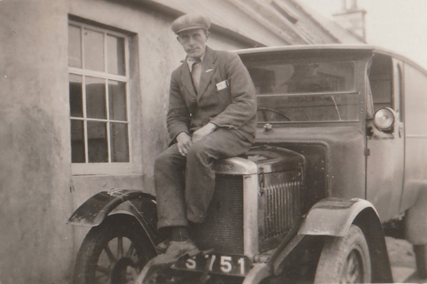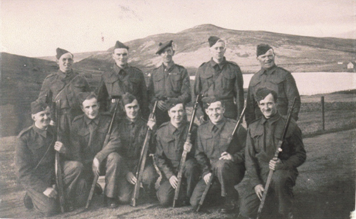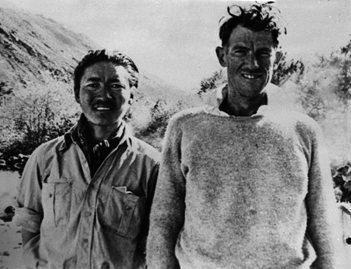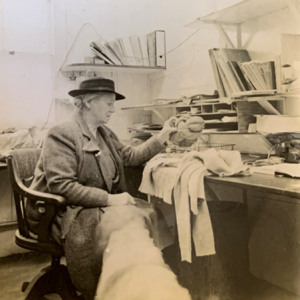
(Photo approx.1870, image supplied by Sarah, Martin & Chris Adie)
Voe House was built for Thomas Mountford Adie, around 1862. He was then a successful businessman. Thomas, one of a family of 11, was born in Walls on the west side of Shetland, where the family had lived since 1807. His father, Dr John Adie, was a naval surgeon. They moved to Voe around 1827, to rented accommodation in what became known as the Old House of Voe.
Thomas was still only fifteen years old when he carried a sack of goods on his back from Lerwick and sold them from home. Thereafter, he built up a general merchant’s business, built a separate shop by the waterside, and by and by ventured into fishing and fish-curing. By 1872, at the height of the cod-fishing years, he was employing about 400 fishermen, with 30-60 curers, based in various parts of Shetland. In the 1880s, the firm also became involved in herring-fishing, which lasted into the early years of the 20th century.

(Photo taken in 1870s, image supplied by Shetland Museum & Archives)
T.M. Adie married in 1834, and had a family of 13, of whom 12 survived into adulthood; the old house they lived in became very crowded. ‘You have no idea,’ he wrote once in a letter, ‘how we are packed together in the uncomfortable place we occupy.’ He promptly set about solving the problem, and Voe House was built around 1862. It was an Adie family home for over a hundred years.
In the 1870s, two of Thomas’s sons, William Adie and Thomas Mountford Adie II, became partners in the business, with William Adie being the principal partner. The firm became T. M. Adie & Sons, and retained the name until its eventual closure a hundred and twenty years later.

(Image supplied by Shetland Museum & Archives)
Photo taken about 1892/3. The two little girls are probably T. M. Adie’s grand-daughters, Edith Maud Adie (b.1884) and Wilhelmina Jamieson Adie (b.1880), daughters of T.M. Adie II.
Adie’s smacks fished for cod as far away as Rockall, Faroe and Iceland. Faroe trips regularly involved the smuggling of brandy and tobacco into Shetland. Many stories used to be told about such exploits. It is said that Adie’s took a relaxed attitude to the smuggling, and preferred ‘not to know’. However, it seems that they were not above receiving a little contraband, and that it was stored safely in a hidey-hole in Voe House. To date, this secret place has not been discovered!

(Image and supporting information supplied by Sarah, Martin & Chris Adie)
The family of William and Margaret Adie taken at the back of Voe House. There was soon to be a double wedding in the family: both Tilda and Daisy married on 10th August 1901.
Back row left to right: James Arthur Adie [Jim] b. 19/9/1875, d. 4/5/1948; Maria Isabella Cooke Adie [Myra] b. 17/5/1871, d. 28/2/1965; Montford Westile Jamieson Adie [Monty] b. 28/6/1877, d. 6/6/1903; Wilhelmina Jamieson Adie [Winnie] b. 27/4/1872, d. 3/1/1921; William Jamieson Adie [Willie] b. 21/10/1880, d. 28/11/1909; Matilda Annabella Adie [Tilda] b. 7/1/1879, d. 16/3/1960
Front row left to right: Margaret Douglas Gray Adie [Daisy] b. 13/11/1873, d. 26/4/1963; William Jamieson Adie Snr [Will] b. 2/4/1839, d. 1/6/1903; Edward Percival Douglas Adie [Ted] b. 9/9/1890, d. 18/5/1977; Stephanie Gray Adie [Steffie] b. 14/4/1885, d. 26/5/1960; Douglas Cooke Gray Adie [Dudley] b. 9/10/1988, d. 22/11/1960; Margaret Douglas Gray Adie Snr [Maggie] b. 1/12/1849, d.3/4/1922; Eliza Beatrice Adie [Lizzie] b. 17/9/1882, d. 7/1/1938.
It is believed this photograph of the complete family was taken before marriages and departures had their effect. Tilda and Daisy each married in a double wedding in Voe, on 10/8/1901. Winnie married in June 1902, and W.J. Adie Senior died on 1st June 1903, with his popular and well-loved son, Monty, dying 5 days later, both being buried in the Voe Kirkyard. Willie [junior] married in August 1908 and died in the USA in November 1909. Myra set up a temporary home in Edinburgh so that Ted could attend the Edinburgh Academy for education. She returned to Voe to join with Jim as partners in managing T.M. Adie & Sons. Ted and Dudley emigrated to Canada to seek a living. Ted joined the Canadian Scottish Regiment to fight in WW1. Jim left the business in 1922 and Ted took his place as partner with Myra developing the knitwear and weaving business, which along with the bakery and shop brought a measure of success to T.M. Adie and Sons once more.

(Photo taken in early 1920’s, image supplied by Laureen Johnson)
Adie’s fishing interests declined as steam drifters took the place of sail-driven fishing boats. The shop and the family farm continued, and a new, larger shop was built in 1910.
A new opportunity opened up when the Royal Navy 10th Cruiser Squadron came to be based nearby. The Navy needed steady supplies, including meat and bread, and Adie’s rose to the occasion. Meat was at first more easily provided than bread, but in 1915, a handy building near the shop was adapted to become a bakery. ‘Scotch ovens’ were built, bakers were hired, and large quantities of loaves supplied to the Squadron store ship Gibraltar. A Scotch oven was a very substantial construction job – it contained 120 tons of bricks! The bakery became an important part of the business, and in 1920, began to deliver bread to other shops. The bakery continues to supply local shops today under new ownership.

(Photo taken in late 1950’s, image supplied by Shetland Museum & Archives)
In 1922, James Adie and his family left Shetland. His eldest sister Myra and youngest brother Edward (Ted) became partners in the business.
Like most Shetland merchants, Adie’s had always given shop goods as payment for hand-knitted garments and home-woven tweed, which they sold on to interested buyers. Now they planned to do more knitting and weaving on the premises, using the new technology of the day. Their approach was to bring in people with experience to train local folk.
The first weaver at Voe was Tom Robson from the Borders. By 1930, tweed production was well established, several local weavers were fully trained, and were training others. Other jobs accompanied the weaving: warping, washing, finishing and despatching to addresses far and wide, including Italy, Japan and the USA.

(Photo taken in late 1950’s, image supplied by Shetland Museum & Archives)
Locally, hand-knitting skills were already at a high level. The tradition of knitting to sell was ingrained, and all girls learned to knit, to provide (often much-needed) extra income for the family.
Adie’s would continue to trade in hand-knits, but the future lay in the knitting machine.
An instructress from Liverpool was brought to Voe in the late 1920s to train the first two local girls as machinists. Soon a little knitwear factory was established in the old sail loft. By the mid-30s, about 35 female staff were employed there, machinists and ‘finishers’, with a few hands checking and labelling garments. The knitwear side of the business became very busy indeed.
Around 1934, Ted Adie bought a generator which provided electric lights for Adie’s premises, Voe House and Bellevue, his own home. Mains electricity would arrive twenty years later.
(Photo taken very early 1940s, image supplied by Laureen Johnson)
Adie’s was busy in the wartime, especially the shop and the bakery. There were three army camps in Voe, and RAF Sullom Voe was not far away. They all needed supplies, as did the local folk. There was such a demand for bread that army bakers were brought in to help, and bakery staff worked two shifts, the first starting at 2 a.m.
Ted Adie, a First World War Lieutenant, now Major Adie, was second in command of the Shetland Home Guard. He was also County Council Convenor from 1938 to 1945, and had to spend much of his time in Lerwick. His brother James returned to Shetland now, but lived in town, as he and his Norwegian wife were very involved with Norwegian refugees.
Male staff were regularly called up to the forces, and sometimes this resulted in women taking on ‘men’s jobs’, for example, driving and weaving.
After the war years, life was still busy at Adie’s. Tweed production was at its height in the mid-fifties, and knitwear remained steady for a long time. The most famous of Adie’s customers were the mountaineering team who conquered Everest in 1953; the photo of Hillary and Tenzing was proudly displayed at Voe. ‘Everest’ jumpers were made from a special lightweight yarn, and would be in demand for years to follow.

Mountaineers: Tenzing Norgay and Edmund Hillary
(Image supplied by Shetland Museum & Archives)

(Photo taken in the 1950’s in the sail loft, Image supplied by Sarah, Martin & Chris Adie)
The last Adie to live in Voe House was Myra I. C. Adie. The photograph shows her in her office, where she was very much in charge of matters, from checking the quality of knitwear to organising staff. Eldest of the family, she was known to all as ‘Miss Adie’, and called Myra by her siblings. But to the younger members of the family she was always ‘Aunt Mona’.
Miss Adie took her responsibilities seriously, and was not given to frivolity. But once, during the war, some of her young knitwear staff volunteered to become weavers, replacing the men who had gone to enlist. Miss Adie’s reaction surprised them, as one later recalled:
‘When we told Miss Adie that we would go into the weaving shed, she began to laugh non-stop! She laughed and laughed till the tears ran down her face. We never usually saw her even smiling. Well, we didn’t know what to do, so eventually, we just laughed too!’
After the war, with younger family members coming to the fore in the business, Miss Adie, then well over seventy, was able to step back from management, and spend more time at home in Voe House – which also needed some management.
Voe House had staff: cook, maids, handymen. The farm dairy was up at the house. The farm provided milk, cream, eggs etc. Soft fruits were plentiful in the garden: rhubarb, strawberries, blackcurrants, gooseberries. Lots of jam was made, also marmalade. There was a cupboard full of pickled onions and preserves. Nothing was wasted in Voe House.
Miss Adie shared the house with her sister Mrs Hamilton, and other members of the family at different times. Finally, she lived alone, apart from her maid. She died in 1965, at the age of 93.

In 1966 Voe House was sold to Colonel & Mrs Charles Durham, who ran the property as a hotel until 1975. Locals still comment on the standard of the food served which was considered exceptional. The property changed hands again in 1975, bought by a local Shetlander who lived in it for a year. Then in 1976, during the early years of the oil industry in Shetland, it was sold again to BP. The House continued to be owned and used as required by BP and later Enquest until its final sale in 2020 to the present owners, Jeremy & Dawn Goodlad.
Voe House has been a local landmark for over a century and a half; its story is an integral part of the story of the community. Since its foundation, and right up to the present day, it has also seen and reflected great changes in Shetland and in the outside world.
